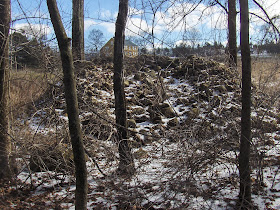Talk about confusing! Half of this pile's attributes are pure field clearing. The other half are pure burial mound, so I have no idea how to judge it. It is fun to discuss.
Some comments:
This pile is at the lower edge of a field. And it is covered with vines. The vines mean that a good deal of dirt was "scooped up" along with the rocks when they were dumped here. It is at the angle of repose for dumped rocks. That is why is is obviously a field clearing pile.
But from an opposing view: the pile is not really at an angle of repose - it is too broad and even on top. Also, all the rocks are the same small size - and what field has discards of such uniform dimension? Finally it has a hollow and so looks like a typical burial mound, if it was seen anywhere else. [That is not entirely true, since most rectangular mounds with hollows are low to the ground and this one sticks way up. It does happen sometimes, I have see tall ones at the top of the Falulah, and further south in Hassanamessit (neither example had a hollow though), so it is possible.]
You can see this mound from East Street in Upton/Hopkinton, about 100 yards downhill to the west, behind the old yellow house:



Is the saltbox house an old house or a reproduction? Is it part of a development where huge trucks dumped whatever stonework was scooped up or dug up or whatever creating a level "blank slate" to build on? I can easily image farmers with the kind of sleds referred to as "stone boats" sometime around 1700 and later filling in low spots with field clearing stones and boulders or dragging them somewhere to build something else, but can't conceive of them being able to convince an ox or two to bring a boatload of stone up to the top of an ever growing pile of stones like this. Why bother? What justifies the extra labor? It seems to make more sense as an Indigenous Stone Ceremonial Landscape feature - the extra effort adds to the Stone Prayer...
ReplyDeleteIts is the original farmhouse for this area - not sure how old.
ReplyDeleteReally nice post.
ReplyDeleteHaemorrhoids piles treatment in delhi